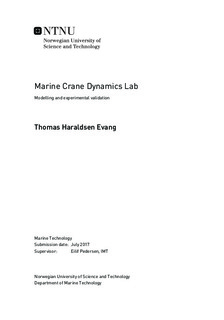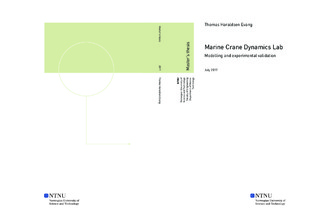| dc.description.abstract | In this thesis, simulation models for a knuckleboom crane and its winch system have been developed. The simulation models have been used to design model based control laws for positioning the orientation of the crane joints and for softly landing its cargo. The control law for positioning the crane has been implemented and tested in an experimental crane lab at the department of marine technology at NTNU. As part of this process, the lab has been improved with a new set of sensors, filters and hands-on control systems.
The simulation model of the crane has been based upon the physical crane in the lab and was derived using Lagrangian mechanics and modelling procedures for robotic manipulators. The model was derived by treating the crane as a system of linked rigid bodies and includes the weight of the actuator, but not their dynamics. The load of the crane was modelled as a constant weight acting at the tip of the crane. Simulation studies of the model has shown that the crane behaves as an undamped, double gravity pendulum when not influenced by external forces, or with limitations imposed on the joint angles.
The control law for positioning the crane joints was designed using the crane simulation model and the non-linear backstepping technique. The procedure yielded a globally asymptotic stable control law for the system. When the control law was tested with the crane simulation model it was able to follow a ramp reference signal lifting and lowering the crane arms and perform heave compensation with the upper arm, with a load of $16\si{\kilo \gram}$ attached to the tip.
Testing the control law in the marine crane lab revealed that the crane was able to follow ramp reference signals and perform heave compensation with the upper arm, without an attached load. However, the lower arm was not able to lift a load of $6\si{\kilo \gram}$ when using a wire with a diameter of $1.7\si{\milli \meter}$. The actuator motor drew full current, but was not able to move the arm. This was most likely due to increased resistance caused by using a thin wire or by the friction profile of the actuator.
The simulation model of the winch has been used to design a control law for softly landing crane cargo. The control law was designed by defining the control objective as tracking, where the wire velocity should follow a desired speed profile. Simulation results have shown that the control law achieved the objective with good accuracy.
The lab has been improved with new gyroscopes that fits the velocity range of the crane and accelerometers that have been attached to the mass centres of the lower and upper crane arm. The accelerometers have been used to measure the absolute orientation of the crane by calculating their orientation relative to the gravitational axis. A low-pass filter has been designed to remove high frequency components from the gyroscope measurements and a Kalman filter to remove noise from the accelerometer and estimate gyro bias. In addition, the crane's winch has been finished and a simple hands on-control system for controlling the winch speed has been implemented. Meaning that the state of the marine crane lab has been improved and that the process of implementing model based controllers simplified. | |

